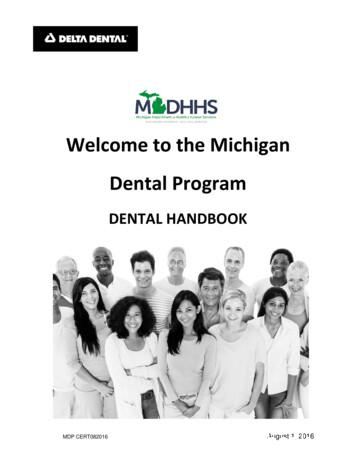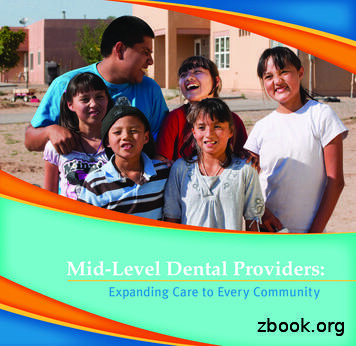SIGN 138 Dental Int Event Caries In Children
Help us to improve SIGN guidelines click here to complete our surveySIGN 138 Dental interventions to prevent caries in childrenA national clinical guidelineMarch 2014Evidence
KEY TO EVIDENCE STATEMENTS AND GRADES OF RECOMMENDATIONSLEVELS OF EVIDENCE1 High quality meta-analyses, systematic reviews of RCTs, or RCTs with a very low risk of bias1 Well conducted meta-analyses, systematic reviews, or RCTs with a low risk of bias1-Meta-analyses, systematic reviews, or RCTs with a high risk of bias High quality systematic reviews of case control or cohort studies2 Highquality case control or cohort studies with a very low risk of confounding or bias and a high probability that therelationship is causal2 Well conducted case control or cohort studies with a low risk of confounding or bias and a moderate probability that therelationship is causal2- Case control or cohort studies with a high risk of confounding or bias and a significant risk that the relationship is not causal3Non-analytic studies, eg case reports, case series4Expert opinionGRADES OF RECOMMENDATIONNote: The grade of recommendation relates to the strength of the evidence on which the recommendation is based. It does not reflect theclinical importance of the recommendation.AB t least one meta-analysis, systematic review, or RCT rated as 1 ,Aand directly applicable to the target population; or body of evidence consisting principally of studies rated as 1 ,Adirectly applicable to the target population, and demonstrating overall consistency of resultsA body of evidence including studies rated as 2 ,d irectly applicable to the target population, and demonstrating overall consistency of results; orExtrapolated evidence from studies rated as 1 or 1 CA body of evidence including studies rated as 2 , directly applicable to the target population and demonstrating overall consistency of results; orExtrapolated evidence from studies rated as 2 DEvidence level 3 or 4; orExtrapolated evidence from studies rated as 2 GOOD PRACTICE POINTS Recommended best practice based on the clinical experience of the guideline development groupNHS Evidence has accredited the process used by Scottish Intercollegiate GuidelinesNetwork to produce guidelines. Accreditation is applicable to guidance producedusing the processes described in SIGN 50: a guideline developer’s handbook, 2008edition . More information onaccreditation can be viewed at www.evidence.nhs.ukHealthcare Improvement Scotland (HIS) is committed to equality and diversity and assesses all its publications for likely impact on thesix equality groups defined by age, disability, gender, race, religion/belief and sexual orientation.SIGN guidelines are produced using a standard methodology that has been equality impact assessed to ensure that these equalityaims are addressed in every guideline. This methodology is set out in the current version of SIGN 50, our guideline manual, which canbe found at www.sign.ac.uk/guidelines/fulltext/50/index.html. The EQIA assessment of the manual can be seen atwww.sign.ac.uk/pdf/sign50eqia.pdf. The full report in paper form and/or alternative format is available on request from theHealthcare Improvement Scotland Equality and Diversity Officer.Every care is taken to ensure that this publication is correct in every detail at the time of publication. However, in the event of errorsor omissions corrections will be published in the web version of this document, which is the definitive version at all times. This versioncan be found on our web site www.sign.ac.uk.This document is produced from elemental chlorine-free material and is sourced from sustainable forests.
Scottish Intercollegiate Guidelines NetworkDental interventions to prevent caries in childrenA national clinical guidelineMarch 2014
Dental interventions to prevent caries in childrenScottish Intercollegiate Guidelines NetworkGyle Square, 1 South Gyle CrescentEdinburgh EH12 9EBwww.sign.ac.ukFirst published March 2014ISBN 978 1 909103 22 1Citation textScottish Intercollegiate Guidelines Network (SIGN).Dental interventions to prevent caries in children. Edinburgh: SIGN; 2014.(SIGN publication no. 138). [March 2014]. Available from URL: http://www.sign.ac.ukSIGN consents to the photocopying of this guideline for the purposeof implementation in NHSScotland.
ContentsContents1Introduction.11.1The need for a guideline. 11.2Remit of the guideline. 11.3Definitions. 21.4Statement of intent. 32Key recommendations.52.1Delivery of dental brief interventions in the practice setting. 52.2Toothbrushing with fluoride toothpaste. 52.3Topical anticaries interventions. 52.4Sealants. 53Predicting caries risk.63.1Introduction. 63.2Caries risk indicators. 63.3Influence of parental oral health status. 73.4Caries risk assessment. 74Delivery of dental brief interventions in the practice setting.94.1Introduction. 94.2Effectiveness of dental brief interventions. 104.3Format of dental brief interventions. 114.4Social determinants of oral health. 115Toothbrushing with fluoride toothpaste.135.1Introduction. 135.2Use of fluoride toothpaste. 135.3Concentration of fluoride toothpaste. 165.4Composition of fluoride toothpaste. 185.5Frequency and duration of brushing. 185.6Age at commencement of brushing. 195.7Toothbrushing practice. 206Other tooth cleaning methods.226.1Introduction. 226.2Dental floss. 226.3Interdental brushes and miswaks. 237Topical anticaries interventions.247.1Introduction. 247.2Topical chlorhexidine varnish. 247.3Topical fluoride varnish. 247.4Slow-release fluoride beads. 257.5Fluoride gels. 257.6Fluoride drops or tablets. 267.7Fluoride mouthwash. 267.8Combined topical interventions. 27
Dental interventions to prevent caries in children8Sealants.288.1Introduction. 288.2Use of sealants. 289Provision of information.309.1Sources of further information. 309.2Checklist for provision of information . 3110Implementing the guideline.3210.1Implementation strategy. 3210.2Resource implications of key recommendations. 3210.3Auditing current practice. 3311The evidence base.3411.1Systematic literature review. 3411.2Recommendations for research. 3412Development of the guideline.3512.1Introduction. 3512.2The guideline development group. 3512.3Acknowledgements. 3612.4Consultation and peer review. 36Abbreviations.38Annexes.39References.41
1 Introduction1Introduction1.1 the need for a guidelineDental caries (tooth decay) is a preventable disease. Dental biofilm (plaque) is a naturally occurring layer ofbacteria and salivary proteins present in the mouth that builds up on exposed tooth surfaces. If not removed,the bacteria metabolise dietary carbohydrates releasing acid into the biofilm layer which, over time, candemineralise the enamel and dentine giving rise to caries. The process is dynamic and can be controlled sothat early lesions do not progress or established lesions can be arrested.Dental health in Scotland has shown a steady improvement since the 1980s. The proportion of primary onepupils with no obvious dental decay has risen from 42% in 1988 to 73% in 2013.1 This still means, however,that more than a quarter of Scottish children suffer with a preventable disease and this burden is greatestin those from disadvantaged backgrounds with just 61% of primary one pupils from the most deprivedquintile of the population free from obvious decay compared with 82% from the least deprived quintile.1Inequalities in dental health have not narrowed significantly in recent decades and public health approachesare increasingly focusing on the social determinants of health. Conceptual models of the factors affectingchildren’s oral health which describe a range of influences at community, family, and child-level, are helpful inunderstanding these wider determinants.2 One approach to addressing many of these factors is the adoptionof the common risk factor approach to disease prevention.3 Diet is one of the common risk factors with arole in dental caries, obesity, heart disease, stroke, cancers and diabetes. The role of diet in dental caries isnot specifically addressed in this guideline as national oral health and nutritional guidance was publishedfor health professionals in Scotland in 2012 (see section 1.2.1).4Recommendations from previous SIGN guidelines on dental caries have been incorporated into the ScottishDental Clinical Effectiveness Programme (SDCEP) guidance on the prevention and management of dentalcaries in children.5 They have also informed the development of the national Childsmile programme(www.child-smile.org) which provides a comprehensive, free, public health pathway for disease preventionand care to all children and young people in Scotland up to the age of 17 years.While wider public health- and population-based programmes such as the Childsmile programme areimportant to develop and maintain there are still marked differences in the use and delivery of preventiveapproaches in dental practice. Consequently, there is still a need to review and update the evidence inorder to clarify which techniques and approaches are the most effective. Due to variation in frequency ofpresentation of children to primary dental care services it is particularly important to take full advantageof episodes when children attend for dental care. The preventive potential of one-to-one interactionsbetween members of the dental care team and children should be maximised by focusing attention on keyinterventions and messages.1.2REMIT of the guideline1.2.1 overall objectivesThis guideline provides recommendations based on current evidence for best practice in dental interventionsto prevent caries in children and young people aged 0–18 years carried out by dental care teams withindental practices in Scotland. The guideline focuses on advice or interventions that are applied at an individualrather than a population level. This does not imply that population-based approaches are not important ornot recommended.In Scotland, population-based approaches designed specifically to improve children’s dental health aredelivered within the Chil
This guideline replaces SIGN guideline 47 on preventing dental caries in children at high caries risk and SIGN guideline 83 on prevention and management of dental decay in the pre-school child. While the whole guideline has been newly developed, section 3 on predicting caries risk has been drawn from these previous guidelines. Section 3.4.1 has .
Event 406 - Windows Server 2019 58 Event 410 58 Event 411 59 Event 412 60 Event 413 60 Event 418 60 Event 420 61 Event 424 61 Event 431 61 Event 512 62 Event 513 62 Event 515 63 Event 516 63 Event 1102 64 Event 1200 64 Event 1201 64 Event 1202 64 Event 1203 64 Event 1204 64
DENTAL SCIENCES 1 Chapter 1 I Dental Assisting— The Profession 3 The Career of Dental Assisting 4 Employment for the Dental Assistant 4 The Dental Team 6 Dental Jurisprudence and Ethics 12 Dental Practice Act 12 State Board of Dentistry 12 The Dentist, the Dental Assistant, and the Law 13 Standard of Care 13 Dental Records 14 Ethics 14
Cigna Dental Care DMO Patient Charge Schedules 887394 09/15 CDT 2016 Covered under Procedure Code1 Dental Description and Nomenclature Cigna Dental 01 and 02 PCS Cigna Dental 03 PCS Cigna Dental 04 PCS Cigna Dental 05 PCS Cigna Dental 06 PCS Cigna Dental 07 PCS Cigna Dental 08 PCS Chair Time Per Y/N Minutes Code # (if different) Y/N Code # (if .
9 138-0867-03 1 Guard-Muffler 10 138-6036-03 1 Support-Seat 11 138-2548 2 Spring-Compression 12 138-9820-03 1 Guard-Engine 14 138-9827-01 1 Footrest 15 140-2097 2 AxleStubASM 15:2 109-3678 2 Bearing-Ball Ref. PartNumber Qty.Description 17 138-7200 2 Cap-Grease 18 117-1232-03 1 Bracket-Hitch 20 139-5890 1 Decal-Timecutter 21 139-2387 1 Decal .
is a detailed list of dental services provided by a dental office and given to Delta Dental for payment. Delta Dental means Delta Dental Plan of Michigan, Inc., a service provider for dental benefits under the Michigan Dental Program. Delta Dental ID Card is a permanent (not monthly) card. We send
Mid-level dental providers, variously referred to as dental therapists, dental health aide therapists and registered or licensed dental practitioners, work as part of the dental team to provide preventive and routine dental services, such as cleanings and fillings. Similar to how nurse practitioners work alongside physicians, mid-level dental .
Jun 14, 2016 · active duty Soldiers treated at any of five dental clinics on Fort Bragg. These clinics included Davis Dental Clinic, Joel Dental Clinic, LaFlamme Dental Clinic, Pope Dental Clinic, and Smoke Bomb Hill Dental Clinic. For each appointment the appointment type, date, and dental wellness class
The level of management responsible for developing strategic goals is: A. line B. supervisor C. functional D. senior . D. other organisations that do business with the 14 Where a stakeholder is identified as having high interest and low power, an organisation should: keep them satisfied monitor their interests and power C. manage them closely keep them informed 15. Highfield Aeet 12 .


















